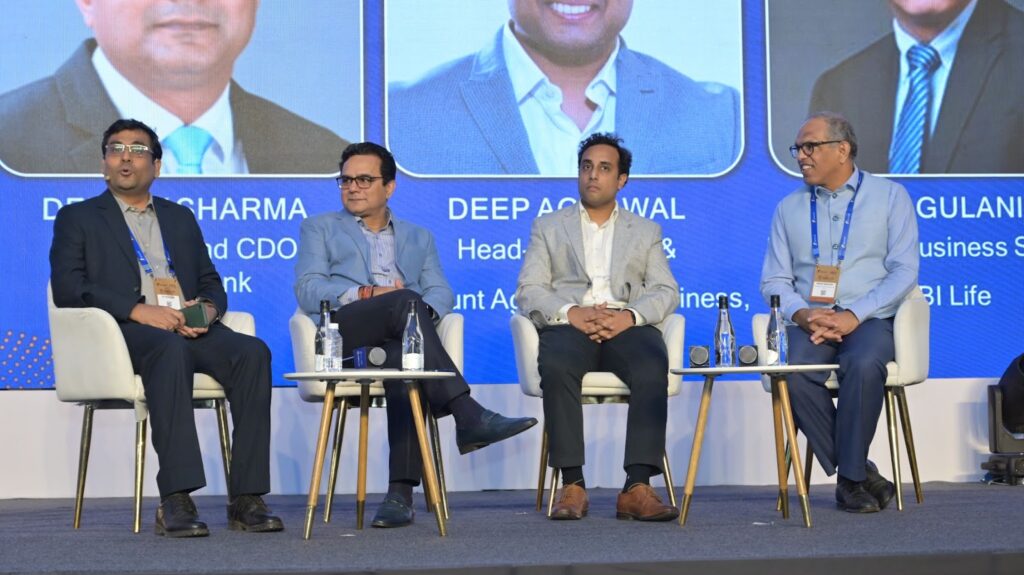Let's open finance: The how-to guide for India | Key takeaways

The Samvaad 2023 panel entitled “Let’s open finance: The how-to guide for India,” explored some of the most urgent questions on open finance in India – the current state of the industry, its goals, challenges, and lessons from India’s previous experience in digital public infrastructure.
The panellists – Deepak Sharma, President and CDO at Kotak Bank, Deep Agrawal, Head of Payments & Account Aggregator Business at PhonePe and Abhijit Gulanikar, President, Business Strategy at SBI Life drew on their experience working in this area to share their insights.
Here are the key takeaways from the panel discussion:
India is well-positioned for open finance as it becomes data-rich before becoming economically rich, enabling new credit access opportunities. Though open finance is in its early stages, it is set to succeed, much like previous initiatives such as Aadhaar, UPI, and GST. Privacy, consent, custodianship of data, and value creation are key challenges. Bold conversations are necessary to overcome obstacles and drive faster progress in open finance.
India’s formal financial services market has low penetration levels in payments, credit, and insurance. We can see some changes in the next five years, taking cue from payments. The success of payments can be attributed to UPI, which offers an open, interoperable framework for ecosystem players to develop products and experiences. Adopting a similar approach can boost credit and insurance penetration. However, it’s crucial to create value for all stakeholders, including financial institutions, users, and merchants.
Insurance penetration in India is hindered by limited access to data for individuals in the unorganized sector. The account aggregator framework (AA) offers a solution by enabling secure and efficient sharing of financial data. Some banks and financial institutions are already utilizing the AA, and its full implementation is imminent. With the AA in place, onboarding customers from the unorganized sector for insurance products will become easier. This will enhance insurance penetration across India, extending coverage to individuals in all economic sectors.
The success of UPI was due to a combination of factors, including demonetization, government support, and the COVID-19 pandemic. Besides external factors, it is important to understand the needs of users and create a product that solves their problems in a simple way. For example, PhonePe’s “Pay to Self-Account” feature is a simple and effective way to transfer money between accounts. It was created based on observation and feedback from the users.
Building businesses around universal needs like financial control, trustworthy guidance, privacy, retirement planning, and debt management is crucial. Various businesses have emerged to address these concerns, including price comparison platforms, insurance marketplaces, and wealth technology. Account Aggregator (AA) recognizes the value of personal data and leverages it to provide valuable services, like suggesting lower-interest loans and assisting with financial planning. However, it is essential to view this opportunity as a means to genuinely improve people’s lives rather than solely for commercial gain. By focusing on a broader vision and considering the roadmap ahead, profit will naturally follow, while skepticism and resistance within the ecosystem can be minimized.
Everyone wants to be a Financial Information User (FIU), but there are no clear guidelines for Financial Information Providers (FIPs). Questions arise about data contribution and incentives for participation. These issues should be discussed among smaller groups and addressed industry-wide. It is important to consider doubts and imbalances, such as NBFCs fetching data without contributing their own. To encourage investment in technology, there should be a sense of urgency and sufficient investment in technology bandwidth. For example, in the case of UPI, there should be a shared fee model to compensate for the investment made by players. This will align interests, promote data sharing, and incentivize technological investment.
We would like to thank Mr. Ramnath, for his contribution to the blog
Related Readings
